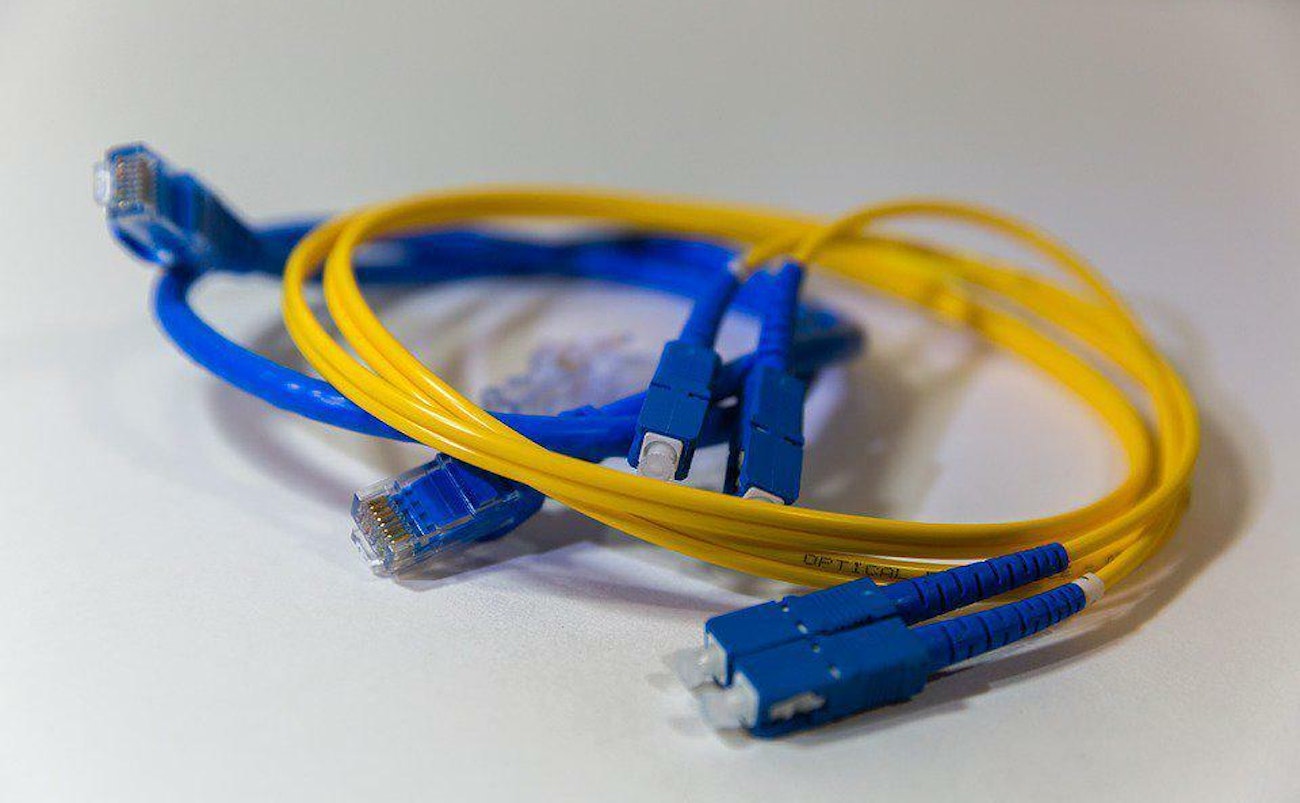How Broadband and Leased Lines are different

Leased lines and broadband are different in seven key areas:
- Speed
- Contention
- Latency
- Scalability
- Symmetricality
- Jitter
- Service level agreements (SLA)
In this blog post, we will tell you:
- What a leased line is
- What broadband is
- The seven ways leased lines and broadband differ
- The three questions you should answer before choosing one
What is a Leased Line?
A leased line provides your business with a superfast internet connection. It can be deployed in one of two ways: with fibre optic cables or a wireless antenna. For the former, roads have to be dug up so the cable can be connected to your office. For the latter, an antenna is fitted to the roof of your building.
While the installation methods are different, the benefits are universal:
- Superfast speeds: these can range anywhere from 100 megabytes per second (Mbps) to 10 gigabytes per second (Gbps). In other words, it is really, really fast
- Uncontended network: you are not sharing your connection with anybody else. So it will never be slowed down by external interference
- Low latency: when you click on a web page, it will load quickly
- Scalability: it is easy to scale down your bandwidth if you don’t need as much, or invest in more if you feel you need it
- Symmetrical uploads and downloads: you can upload and download files at the same speeds
What is Broadband?
As with leased lines, broadband internet also offers a high-speed internet connection. It used to go by the name narrowband because you had to disconnect your phone line in order to use it. But that is not required anymore. Now, broadband is always-on.
There are several types of broadband:
- Fibre-optic: uses fibre-optic cables to connect your business to the internet
- Asymmetric digital subscriber line (ADSL): uses copper telephone lines to get you connected
- Mobile: uses digital signals to transmit connectivity from satellites to you
Unlike a leased line, however, broadband is contended. So when you are using your connection, there is a good chance several other people will be too. This can have an impact on the speeds you are actually able to get.
Where speeds are symmetric on a leased line, they are asymmetric on broadband. This means download speeds are faster than upload speeds.
The Difference Between Broadband and Leased Line Connections
At the start of this post, we said there were seven areas in which leased lines and broadband differ. These are:
- Speed
- Contention
- Latency
- Scalability
- Symmetricality
- Jitter
- Service level agreements (SLA)
Here, we will go through each of them in detail.
Speed
Leased lines and broadband will state they come with superfast speeds. There is no denying this on leased lines. The same cannot always be said for broadband.
If you have bought a leased line with 20Mbps, this is the speed you will always get as you are using an uncontended network (more on this next).
But with broadband, you stand a good chance of receiving a slower speed than what you were promised. This is because broadband works on a contended network (more on this next, too).
So your 20Mbps connection is more likely to be 17Mbps at times.
Regulators are aware of this issue, however. In March 2018, Ofcom announced protections to ensure broadband suppliers provide more accurate speed estimates to their customers.
Contention
Contention determines if you are using your connection alone or sharing it with others in the area.
Leased lines use an uncontended network. There is nobody using this except you, so your connection won’t be slowed down by other users in the area.
Broadband is contended, so you are sharing your connection with several other users. This can reduce your speed at peak times.
Latency
Latency is the time it takes for an action to respond after you have clicked on something. If latency is low, it will not take long for the action to happen. If it is high, the action will take a bit longer.
Leased lines have low latency. When you click on a web page, it will not take long for this to load.
Conversely, broadband has higher latency. So it will always take a little bit longer for web pages to respond.
Scalability
Scalability sets out how easy it is to make alterations to the bandwidth you get each month.
Most leased line connections are scalable. You can invest in more bandwidth if you find yourself needing it, or scale it back if you need less.
Some broadband packages come with flexible bandwidth options, but the availability of these is decreasing. So you might find yourself stuck on a fixed package.
Symmetricality
Symmetricality determines if your upload and download speeds are equal. A connection can be symmetric or asymmetric.
With leased lines, it is the former. So if your download speeds are 1Gbps, so are your upload speeds.
Broadband is the latter. If your download speeds were 24Mbps, your upload speeds might only be 1Mbps. Or possibly even slower, as broadband is highly contended. This can cause frustration when uploading files - like photos to Dropbox - or if you are playing a HD online multiplayer game.
Jitter
Jitter defines how reliable your connection is during audio and video communications.
Leased lines have a low jitter rate. In other words, your telecommunications are likely to always work in real-time.
Broadband has a high jitter rate and is more prone to connection drop-outs during video calls.
SLA
A SLA is a provider’s commitment to ensuring you have a reliable service at all times.
Many leased line providers offer an SLA of around 99.9% or higher. Given that leased lines are uncontended and use reliable, monitored hardware, it would be extraordinary for the connection to suddenly drop out. If it did, your provider would automatically be alerted and committed to resolving this in a matter of hours.
Broadband SLAs work differently. Typically, these are around 95 - 99%. Response times to outages can vary, depending on the specifics of your agreement. These can range from the same day to 48 hours, so check the details of your agreement carefully. The SLA is reliant on you informing the supplier of an outage.
Before Choosing a Leased Line or Broadband, Ask Yourself Three Questions
You have just heard how a leased line is generally more dependable than broadband. But before ruling out broadband completely, you should consider these three important questions:
- How many users are in my network?
- What applications are they using?
- How crucial is the internet to my daily routine?
How many users are in my network?
If you are in a small company and have less than 10 users, then broadband may be ideal for you.
But if there are more than 10 network users, a leased line will be far more useful for you.
What applications are my users running?
If you use a lot of cloud-based application on a daily basis, or depend on transferring large files a lot of the time over email, you should consider a leased line. For anything else, broadband should suit your needs just fine.
How crucial is the internet to my daily routine?
This might seem like a silly question, as you probably use the internet every day. What you should really think about here is what happens in the event of an outage. Ask yourself: ‘If the internet cut out, would it bring everything I do to a halt?’
You might find there are some things you can do in the short-term without the internet. In which case, you should consider broadband. The SLAs for this mean you could be without a connection for up to 48 hours, which is not too long.
If going without the internet is not an option, however, then you will want a leased line. The SLA for this ensures you will only be without the internet for a few hours.
Read more: leased line comparison - what you need to know
Leased Lines Are More Dependable than Broadband
Now you know about the difference between broadband and leased line connections. When it comes to choosing between a leased line or broadband, a leased line connection is more reliable for seven reasons:
- Speed. Leased lines will always come with the speed advertised. Broadband is more likely to be slower than what it says.
- Contention. You will never share your leased line connection with anyone else as it is uncontended, and speed won’t be impacted. Broadband is contended, and likely to become slow during peak times.
- Latency. Leased lines have low latency, so actions will respond fast. Broadband has high latency, so actions will happen slower.
Scalability. If you need more or less bandwidth, it is easy to adjust this with a leased line. Scalable broadband packages are not as widely available as they used to be, so it can be hard to find one. - Symmetrical. Upload and download speeds match on a leased line. On broadband, uploads will always happen more slowly than downloads.
- Jitter. Video and audio calls are unlikely to cut out on a leased line. Broadband is more likely to suffer an outage.
- SLA. If your leased line connection drops out, your provider is contracted to fix it quickly. Broadband SLAs are not always as tight, so you may have to wait longer for repairs.
But that is not to say broadband is totally irrelevant. If you have less than 10 users who aren’t using cloud-intensive applications, and can work without the internet for a short period of time, it can serve you well.
But companies with 10 or more employees using cloud-heavy applications, and depending on connectivity at all times should strongly consider a leased line.
For more information about leased lines and to see what is available in your area, contact us for a leased line quote. We will provide you with the best price possible and lots of detail on installation timeframes.
Photo by Stephen Phillips on Unsplash





